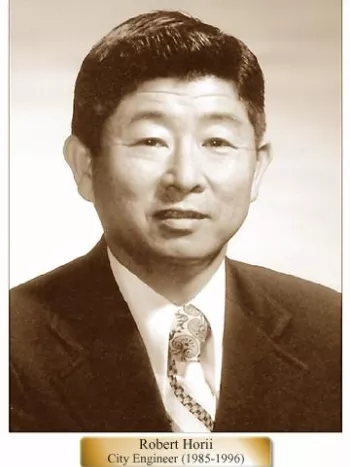
Robert Horii is a native of the South Bay area. He grew up during World War II and later attended Redondo Beach High School. He received his Associate of Arts degree in Engineering from El Camino College in 1951 and acquired his Bachelor of Science degree in Engineering from the University of California, Los Angeles. Horii’s career with the City of Los Angeles spanned for over four decades, from 1953 to 1996.
When he graduated in 1953, the United States was immersed in the Korean War. Robert Horii was an ideal candidate for the draft.
“I was 1A, and subject to the draft,” Horii said, referring to his high draft rating, “No one wanted to hire 1As.”
During the same time the City of Los Angeles was hungry for engineers to work on a bond project to upgrade the City’s storm drains. In June 1953, Horii entered City Service at the class of Civil Engineering Assistant. Six months later the U.S. Army drafted him.
Horii returned to the City after serving for two years in Alaska. He spent the next several years working in storm drain design. In the early sixties he worked on the programming for the first computerization of the City’s storm drain runoff.
In August of 1964 Horii left City Hall for the Bureau of Engineering’s West Los Angeles District Office. As Assistant District Engineer, and later District Engineer, Horii witnessed first hand the sudden increase in hillside subdivisions. Those myriad subdivisions naturally required countless public works improvements. So dedicated was Horii that he spent all night watching over the large Franklin Canyon dam and debris basin during the worst of the huge flood of 1969.
Horii transferred to the Bureau’s Wastewater program in February 1971. The same year voters approved a $100 million bond initiative. Coupled with grant money approved by Congress having passed the Clean Water Act, the City now had the means to begin construction of direly needed water treatment facilities. He led the planning, design and construction of the City’s modern wastewater treatment and conveyance system improvements over the next 25 years. These included the planning, design and construction of the Terminal Island, Los Angeles-Glendale and Tillman Plants water reclamation plants. He spearheaded the North Outfall Replacement Sewer and the East Central Interceptor Sewer tunnel projects that extended from Hyperion east of the Los Angeles River.
As City Engineer, he pushed hard to improve the quality of the City’s wastewater treatment. In 1987, Hyperion’s Energy Recovery System allowed the plant to end sludge disposal in the ocean. At his urging work began to expand and convert the Hyperion Treatment Plant to full secondary treatment. These two projects jointly received the greatest accolades in Los Angeles’ Public Works history. The American Public Works Association named them “One of the Top ten Public Works Projects of the 20th Century”, and Engineering News Record magazine named them to be in the top 125 projects worldwide in civil engineering in the past 125 years.
After the Northridge Earthquake devastated many parts of the City, the Bureau of Engineering assisted in the demolition of unsafe buildings and by hauling away 1.3 million tons of debris.
The City’s Central Library suffered a disastrous fire in the mid 1980’s and the Bureau was in charge of efforts to reconstruct and expand the Library System’s flagship location.
While Horii was City Engineer, a Blue Ribbon Committee, chosen by Mayor Riordan, recommended to abandon historic City Hall because of earthquake damage and construct a replacement. Horii, along with the Council President and Chief Legislative Analyst, raised a strong opposition to the plan. They successfully convinced the City Council to reject the Mayor’s plan and instead, to seismically retrofit and renovate Los Angeles’ City Hall allowing the historic building to continue to serve for decades into the future.
Robert Horii retired from City service in 1996. After an exhaustive and productive career with the City, Horii left a legacy for its citizens of 1500 projects with a combined construction value that exceeded $4 billion.